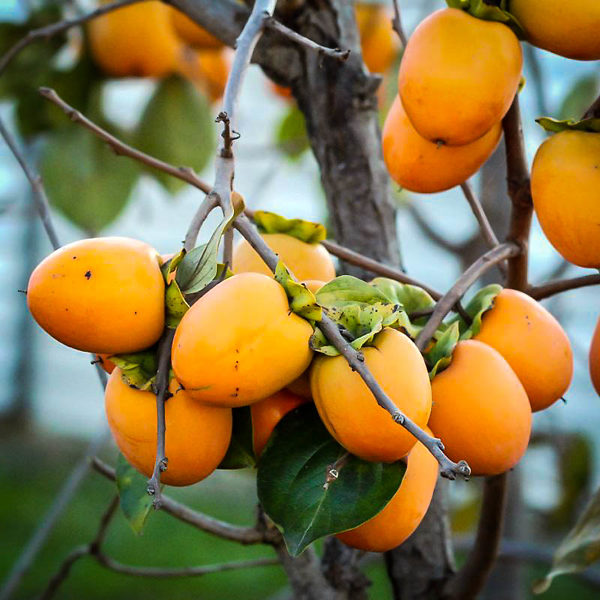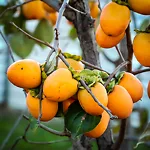
Saijo Japanese Persimmon Tree
Diospyros kaki 'Saijo'View more from Persimmon Trees
Saijo Japanese Persimmon Tree
Diospyros kaki 'Saijo'
30 day - ARRIVE AND THRIVE™ guaranteeLearn more


Special Features

Botanical Name
Diospyros kaki 'Saijo'
Outdoor Growing zone
6-9
Mature Height
15-25
Mature Width
10-12
Sun needs
Full Sun, Partial Sun
The Saijo Japanese Persimmon is the very best variety available for eating fresh. Japanese persimmons have become very popular in the last few years, and their soft and delicious flesh is widely appreciated eaten fresh, or in baking. The delicious orange fruit of this tree ripens in the fall, and for the best flavors they should be allowed to ripen completely indoors until they are very soft. The tree is easy to grow in any warm region, and this variety can even be grown successfully in zone 6. It makes an attractive garden tree, with bold, glossy leaves that turn wonderful shades of yellow, orange and red in fall. The fruits hang on the tree after the leaves drop, and they can be left there for weeks before harvesting and ripening them fully indoors.
- Delicious orange fruit with very few seeds
- Best variety for eating fresh
- Beautiful tree with great fall colors
- Self-pollinating, so perfect for smaller gardens
- Easy to grow and trouble-free
The Saijo Japanese Persimmon tree is easy to grow and free of pests and diseases. It needs no elaborate spraying, as many other fruit trees do. Plant in full sun, in rich, moist but well-drained soil. Regular watering in summer will ensure a top-quality crop. This variety is self-pollinating, so you don’t need to plant a second variety – a great space saver. The word ‘saijo’ in Japanese means ‘the very best one’, and that tells you that this is the variety you should plant.

If you have seen large orange fruits, with a green stalk like a tomato, on sale in fall and winter, then you have seen the Japanese persimmon fruit. It has only been widely available for a few years in many areas, but the tree has been cultivated for at least 2,000 years in China, and almost as long in Japan. In the East these fruits are widely eaten, but many people in America are not too familiar with them or know how they should be eaten. Even fewer know they can be grown in your garden, as an attractive tree with many interesting features besides the delicious fruit.
There are many different varieties of Japanese Persimmon, and they were not all created equal. If you want the very best flavor for fresh eating, the Saijo Japanese Persimmon is the one you need. The fruit is a little smaller than some other varieties, and it is longer and egg-shaped, rather than round like most others. For fresh eating when fully ripe, it cannot be beaten. It has very few seeds, making eating it very easy, the flesh is smooth and creamy, and the flavor is simply delicious.
If you have tried a persimmon and not enjoyed it, you probably didn’t let it ripen enough. These fruits must be kept until they are almost over-ripe, when the flesh will have become very soft and almost liquid. At that stage the sharp bitter taste of the unripe fruit disappears, and is replaced by a delicious sweetness, reminiscent of apricots. Many people leave the fruit until it is soft enough to eat straight from the waxy skin with a spoon – scrumptious!
Growing Saijo Japanese Persimmon Trees
The Saijo Persimmon Tree is a small deciduous tree, reaching more than 15 feet tall and over 10 feet wide. In time, trees will often grow rather larger than that, so allow room for growth when choosing a planting spot. The tree has large leaves up to 8 inches long, with a leathery texture, glossy green on the upper side, and with a soft brown ‘fuzz’ on the lower side. In fall the leaves turn beautiful shade or yellow, orange and red, adding to the fall display in your garden. In spring the tree produces small but attractive flowers in pink or white. The white flowers produce fruit, and the pink flowers – which may be rare on a tree – produce pollen.
Planting and Initial Care
This variety is more cold hardy than some others, growing from zone 6 to zone 9. It should be planted in full sun, in rich, well-drained soil. Established trees can tolerate some drought in a normal summer. The tree is resistant to pests and diseases and unlike many other fruit trees it does not need spraying – another benefit when growing this tree. It also needs no pruning, except for removing any crossed and rubbing branches. It can be pruned in winter to reduce the size if you wish, but do not prune hard or flowering will be reduced.
Harvesting Your Fruit
However, the Saijo Persimmon Tree is self-pollinating, so it does not need a second tree – another benefit, and one that makes this tree an ideal choice for a smaller garden. In fact, trees that are not pollinated produce very few seeds in the fruit, which is an advantage for eating. The fruits develop over summer, and they begin to turn yellow and then orange in fall. The fruit remains on the tree after the leaves fall, looking strikingly attractive, and can be left to slowly ripen in the cooler weather. Fruit continues to ripen after picking, and it should be handled with care, to avoid splitting the skin. It should be further ripened indoors until it becomes completely soft and sweet. Under-ripened fruit is bitter, with a high tannin content, and most people do not enjoy it.
History and Origins of the Saijo Japanese Persimmon Tree
The Japanese Persimmon (柿) (Diospyros kaki), is also known as the Asian Persimmon, or the Kaki Fruit. It grows naturally in China, Japan and Korea, and it is related to American Persimmon (Diospyros virginiana) which grows in the east, and the Texan Persimmon (Diospyros texana). These trees have much smaller fruits, which are also edible. There are many forms of Japanese Persimmon cultivated in China and especially in Japan. The variety ‘Saijo’ is a Japanese word meaning ‘the very best one’, and that is from a people that really know their persimmons. If you want to grow a persimmon that can be eaten before turning soft, and that lacks the bitter tannin, grow the variety ‘Fuyu’, famous for being good to eat when still crisp, and great in salads.
Our trees are produced by joining stem pieces of the correct variety onto the roots of the American Persimmon, which produces a tree that will grow well and fruit early in its life. Japanese Persimmon has become very popular lately, and ‘Saijo’ is the very best there is. Our plants will be sold very quickly, so order now while we still have stock available.







